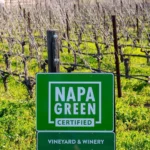RISE GREEN Climate and Wine Symposium’s Grand Finale: Resilience Through Biodiversity
-
 Pam Strayer | Wine Business Monthly
Pam Strayer | Wine Business Monthly
- |
The final, “big picture” day of Napa Green’s third RISE Climate & Wine Symposium presented an almost dizzying array of global, national and local experts grounded in both science and viticulture who shared best practices on everything from gully stuffing, rehydrating vineyards and the vital importance of using native plants in cover cropping to dam removal and the return of salmon, fire prevention grants, student activism, and insights from a world renowned ecosystems and biodiversity expert.
While it might be easy to dismiss these topics as economically non-essential, presenters made the point that fire, water and climate are affecting the wine industry and recommended essential steps to mitigate those impacts in order to make the industry resilient.
The May 8th event was the sixth in the six day series of RISE sessions, which will all be posted on risegreen.org’s website in the coming weeks.
Morning Session: Can Forest & Creek Restoration Create Localized Climate Cooling?
An eclectic panel featuring an artist, watershed experts and a Napa vineyard director focused on practices that could change climate impacts on a regional scale.
Leading off, the popular California writer and illustrator Obi Kaufman, author of Heyday Books’ popular nature field guides, opened by acknowledging that the day was Sir David Attenborough’s 99th birthday. After southern California experienced massive fires in January, his newest book State of Fire, Why California Burns, became an instant LA Times bestseller.
Fire fears and water woes topped Occidental Arts & Ecology Center’s (OEAC) Brock Dolman’s talk, often delivered in colorful rhyming language that brought amused laughter (as intended) from the audience. Among other things, he advocated for gully stuffing–using downed trees and slash from fire fuel reduction (or post fire clearing) to slow, spread, and sink water in gullies, promoting soil health and water infiltration. OAEC has a video on their website with more information.
Presenting together, Tod Mostero, director of viticulture and winemaking at Dominus Estate and Mimi Casteel, an Oregon based agroecologist with a degree in forestry, focused on restoring ecosystem function at farm scale and building community to achieve ecosystem wide, watershed goals. (Casteel is a second generation winemaker turned no till evangelist from the pioneering Casteel family who founded Bethel Heights in Oregon.)
Their joint talk featured a slide on the effects of keeping ground covered, showing that soil temperatures on a heat dome day varied as much as 65 degrees depending on whether the soil was bare or grew a cover crop.
On the water front, they showed data illustrating that with far fewer days of rain, historic monthly maximums can now be daily maximums.
Using VineView data to measure the thermal effects of tillage in 2024 on a 97 degree day, Mostero showed that several tilled rows at Dominus were 140 degrees, in contrast to non tilled rows which registered 120 degrees–a 20 degree difference.
Elsewhere Mostero posted the impact of rising heat on crop losses.
Mostero and Casteel have now launched the nonprofit Abuelitos Foundation to build community around land management and are doing research near Lake Hennessey.
Afternoon Session: Can Wine Really Impact Climate Action?
The all star afternoon panel addressing biodiversity included Napa born Diana Snowden Seysses (a winemaker in both Napa and in France), wine educator and writer Elaine Chukan Brown, and Chilean professor Olga Barbosa, Ph.D., an international expert in ecosystem ecology. Napa Green executive director Anna Brittain moderated.
Snowden-Seysses’ California family’s Snowden Vineyards owns 160 acres of land in the eastern hills of Napa, much of which is forested. “We have block shaped vineyards in the middle of our forests. And we thought that was being green,” she said. But, she added, after the 2020 and 2021 fires,“We realized it was just like a bomb waiting to explode…we just had all this accumulated dry brush material.” They applied for grants, and got funding from the resource district to clear out undergrowth, but that’s covered only a third of the property.
“All of the boon that we have had economically, as people were thirsty during COVID, was sunk into the work that we’ve done thus far. And we’re very proud of it, but it needs to be maintained,” she added. The family is waiting for more grant money and profits in order to go further.
Raised in an Inupiaq-Sugpiaq salmon fishing family in Alaska, Brown applauded the recent dam removal projects that have improved salmon populations.
She also pointed out the downside of previous generations of reforestation in which sugar pines, not native in Mediterranean climates, were planted.
“They’re narrow. The wood is not as dense [as native Mediterranean trees]. They’re much wetter trees, so when they get in heat, they don’t even have to be on fire. When they get in heat, they literally explode from the inside. And when they explode, they spread and they take over the hillside,” she said.
A Biodiversity Scientist’s Perspective
A scientist with a global following, Barbosa, PhD. has worked with leading Chilean wineries (including Emiliana for 15 years) as well as Quintessa and the Napa Valley Grape Growers, to help growers become more resilient in the face of growing uncertainty. She brought a systems perspective, advocating for rethinking concepts about economic models and ag, and pointing to the value that ecosystem services and landscapes provide.
“We have been doing research for 15 years so that we can achieve this conceptualization of the landscape….the interaction of things,” she said.
“We need to talk about a system. When you see the whole system as one, then you will see that there are different benefits and interactions around the system.”
She said conservation is inexpensive and brings financial benefits.
Her advice to growers? “Don’t make a manicured landscape,” she said, adding that nature and biodiversity, and using native species, are the best approach.
“There’s always a risk that we will find an invasive species, and we don’t know how all of them will behave,” she added. Historically, invasive species have created havoc, spreading many vineyard diseases and pests, she said.
Barbosa helped Chilean growers create a new source of cover crop mixes that do not include the California poppy.
She also advocated for creating connected landscapes, used at Emiliana.
In addition to wine grapes, she works with olive oil producers and dairies. She tells producers, “Don’t tell me [conservation] is expensive or that you’re going to lose something. Show me that you are really going to do something. And usually the conversation turns out that they are not going to lose anything.”
Integrating social collaboration is another aspect of her work, which seeks input from everyone. “The guy that does the pruning–that’s the guy that knows where the species that we are looking for are… the CEO might know other things,” she said.
“When you see the whole system as one, then you will see that there are different benefits and interactions around the system….If you have special vegetation that is unique to [your] place, would that signature be in your wine?”


